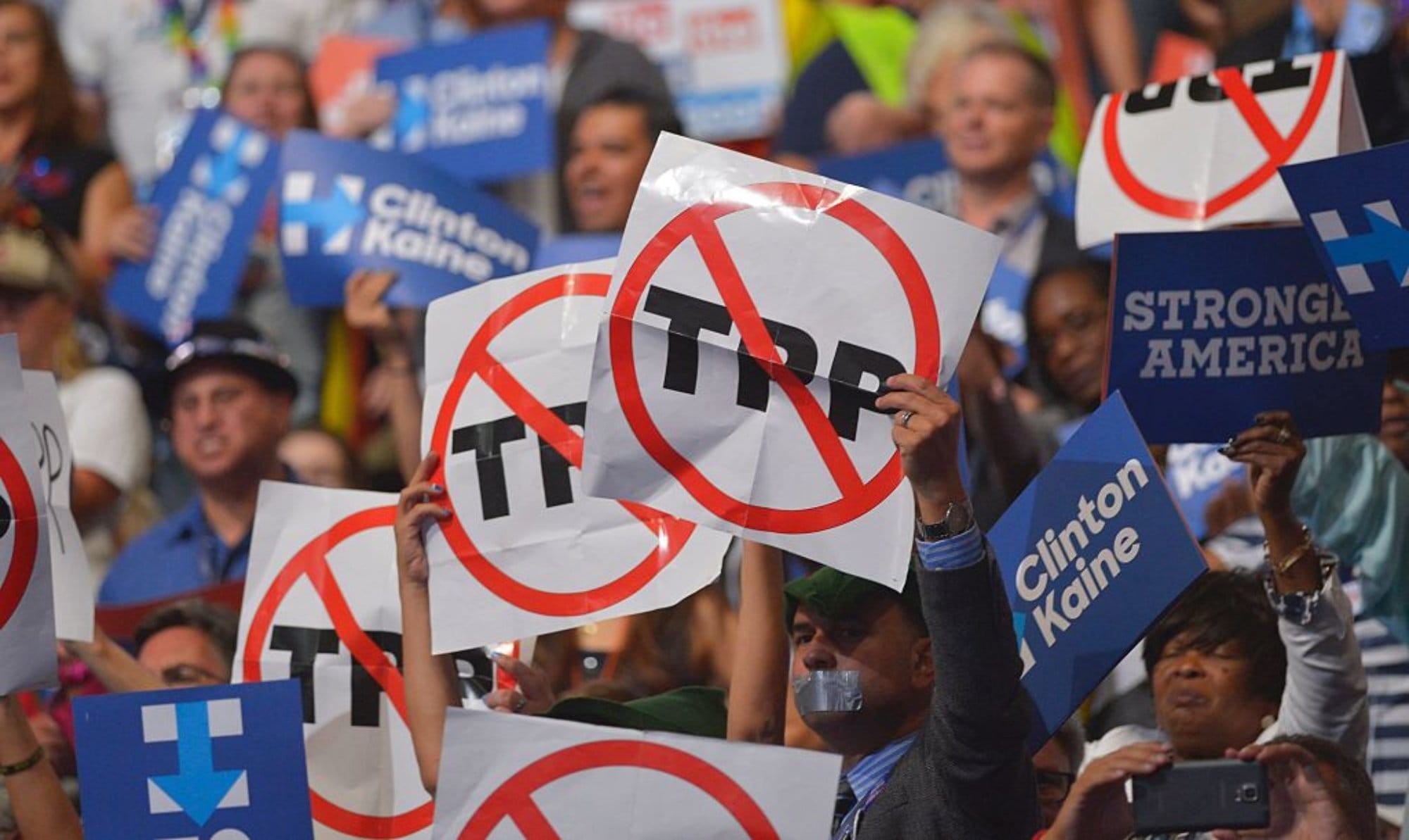After last Sunday’s extraordinary presidential debate, just about the only part of the election campaign where Donald Trump continues to frame the issues concern trade. He says trade with China is destroying American jobs, remembering that Bill Clinton pushed so hard for China’s entry in WTO. Trump calls NAFTA, which Bill signed into law nearly 25 years ago, the “worst ever” trade agreement.
Trump rails against the Trans Pacific Partnership (TPP), a proposed new U.S.-led free trade agreement (FTA) among 12 countries on both sides of the Pacific championed by Barack Obama when Hillary Clinton was Secretary of State. Rather than fighting him on TPP Hillary has folded, saying she no longer supports Obama’s deal.
This anti-trade turn in presidential politics is extraordinary. For nearly 30 years, the elite bipartisan consensus in American politics has been not only pro trade, but very much pro-trade agreements—arguably the core pillar of the post-Cold War “Washington consensus.”
Criticizing trade agreements hasn’t had this much electoral traction since Ross Perot’s infamous “giant sucking sound” of lost jobs to NAFTA in the 1992 campaign. Of course, Perot lost the election and NAFTA ultimately came into force. Things don’t look this good for TPP, even with a Hillary win.
I am not a big fan of TPP. I would prefer a slower path to TPP that includes China in the deal. Trump’s position is very different. He claims TPP will be an American job killer because it will give low wage economies unfair access to the American market without comparable opening of foreign markets to American goods and services.
There are three real problems with this argument:
1. Trade agreements have only a small impact on trade
Politics tend to focus on trade agreements, rather than trade, because politicians can sign agreements. Some people love them, others hate them. But they actually can do little about trade, which is driven by underlying economic factors.
The so-called “gravity model” of trade highlights the importance of geographic proximity—it is easier and more efficient to move goods and services shorter distance. This explains why Canada and Mexico are among the U.S.’s biggest trade partners. Most estimates say NAFTA increased North American trade a bit. But it was already extremely important to all 3 countries long before NAFTA.
When it comes to trade growth, there is no denying that trade has mushroomed in the past couple of decades. But economists tend to emphasize dramatically lower transportation and communication costs as by far the biggest driver of this trade growth. The flurry of trade agreements since the early 1990s probably came about because of these costs of movement, rather than causing them.
Of the U.S.’s top 10 trading partners today, America has FTAs with only three of them (Canada and Mexico in NAFTA, and South Korea in an agreement that only came into force in 2012). What about the argument that FTAs lead to American trade deficits? Of the 10 countries with which the U.S. runs the largest trade deficits, it only has FTAs with two—Mexico and Korea. In contrast, of the top 10 countries with which the U.S. has trade surpluses, it has FTAs with four—Australia, Chile, Panama and Singapore.
Bottom line: there is very little evidence that trade agreements drive overall trade volumes, and even less evidence that the FTAs have increased American trade deficits.
2. TPP ties a bow around existing FTAs rather than creating new ones
The U.S. already has FTAs with six of the 11 other countries that want to be part of TPP: Australia, Canada, Chile, Mexico, Peru and Singapore. Because of these FTAs, there are scarce few restrictions to trade left to remove. TPP boosters talk about “21st century trade agreements” and removing “behind the border” restrictions to trade. But there is little evidence that TPP will move the dial significantly when it comes to the countries with which the U.S. already has FTAs.
What about the other members of TPP? Only one of them is among the U.S.’s top 10 trading partners—Japan. Japan is notoriously protectionist, not only the infamous agriculture cases of beef and rice but also things like restrictions on foreign firms operations in Japan. TPP could potentially change this. But everyone close to TPP knows that when Japan entered the negotiations at the 11th hour, this was only possible because of winks and nods that the core parts of Japan’s protectionist ecosystem would not be touched.
3. Completing TPP would hurt China; not completing it would help China
A casual observer of the debate over trade in the presidential election would likely believe that China is part of TPP, and hence that completing the agreement would only make worse the U.S.’s massive trade deficit with China. This is wrong, for a very simple reason. China is not in TPP.
In fact, the U.S. has pushed TPP as a counterweight to China’s growing influence in the Asian and global economies. Don’t listen to the U.S. Trade Representative. TPP is not fundamentally about reducing trade barriers and boosting trade across the Pacific. It is about laying down “rules of the road” (as President Obama often says) for Asia-Pacific trade in the 21st century. Rules designed by the U.S. Rules that China will have to accept if it ever wants to be part of TPP.
This in essence was the Bill Clinton strategy 20 years ago regarding China and the World Trade Organization. First create WTO under heavy US influence. Then tell China it can join, but only if it is willing to accept America’s rules.
This is why TPP is looming as a geopolitical fiasco for the U.S. After nearly a decade of cajoling other countries to accept parts of TPP they really don’t like (e.g. “investor-state dispute resolution,” giving American MNCs the ability to take foreign governments to court), and convincing pro-free traders that protectionist Japan should be included in the deal, the U.S. now looks likely to walk away from TPP at the alter (if the deal isn’t ratified by Congress, it is dead).
China would be the big winner here. Not only would there be no new Asia-Pacific “rules of the road.” The U.S. would have egg on its face for having pushed other countries, most of which are at least as trade dependent on China as they are on the U.S., into a deal many really didn’t want and on which America ultimately reneged.
I have long believed the best way forward is to use the second guessing in the U.S. to include China in the TPP negotiations. After all, how important is a Trans Pacific Partnership that does not include the world’s largest trading nation? Yes, China is a bigger trader than the U.S. And it just seems silly to talk about a Trans Pacific trade deal that does not include both the biggest trader on the east side of the Pacific, the U.S., with the biggest trader on the west side, China.
But my hopes are looking increasingly like fantasy. The much more likely outcome is that TPP dies in Congress next year, for all the wrong reasons. The Trump candidacy may well have flamed out. But don’t overlook the long run impact of Trumpism, not only on trade but also on geopolitics.
Editor’s Note: This post was originally published on Dean Geoffrey Garrett’s LinkedIn page, where he was named an “influencer” for his insights in the business world. Geoffrey Garrett is Dean, Reliance Professor of Management and Private Enterprise, and Professor of Management at the Wharton School of the University of Pennsylvania. Follow Geoff on Twitter. View the original post here.
























